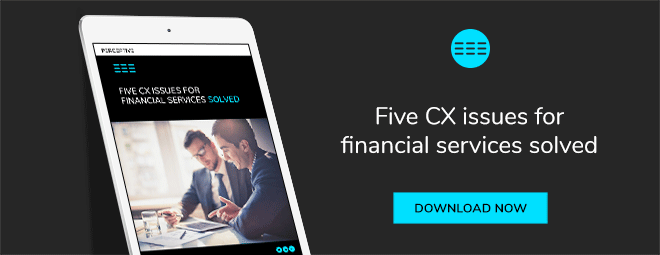With many financial services companies facing customer loyalty issues, a major challenge is trying to retain fickle customers who are always looking for the best deal. Here we'll go through how you can create a solid customer experience map to help keep these customers returning again and again.
Customer loyalty a major issue for financial services
With the pandemic, inflation and cost of living causing increased switching behaviours from financial services customers as people try to find the best deal and value for money. In 2023, Perceptive's In Brief report found that over half of Australian consumers were looking for a new insurance providers for general insurance, car insurance and home and contents insurance. Similar stories are coming from banks and loan services.
Read more: It's time to talk about the Australian insurance market
Enter: customer journey mapping
A customer journey map is a powerful framework that maps out the stages in your customer life cycle. It will tell the story of your customer experience from start to finish, from the initial contact through the engagement process and into a long-term relationship. It identifies the key interactions a customer has with your business, specifically the feelings, motivations and questions your customers have at each touch point. With it, you gain a deeper understanding of what your customers want and what they expect from your business at different stages in their customer journey. Once this is clear, you can work on delivering on those wants and expectations exactly when customers need them.
Why use a customer journey map?
Depending on your specific industry, whether that's banking, insurance, or other financial services, your customers will have specific touchpoints where they interact with your company. This may be going in-store, interacting with your website (including online transactions) and dealing with brokers or agents.
A customer experience map can uncover where you're likely to loose your customers and set you on the right track to recover them. Moreover, it can help you:
1. Make the right decisions
A well thought-through customer journey map allows you to focus in on making the right decisions. It can ultimately build your business objectives for the year. You’ll know what’s working and what isn’t, and where your biggest gaps are.
2. Create a kick-ass product road map
A customer journey map helps you get those aha-moments you’ve been craving. When you sit down and actually map out how your customers use and explore your product or service offerings, you’ll soon see where your business should be focusing their efforts. What do your customers enjoy the most and where do you need to improve? And, naturally you can treat your customers better if you understand what role your business plans in their journey.
3. Prioritise your deliverables
When there are lots of things going on, the tendency can be to try and do it all or let things slip. A solid customer journey map can help you with prioritising what’s important to save those all-important customers.
Read more: Customer experience best practice for financial services
Where do I start?
A good starting point is to immerse yourself in the customer experience. Here are five things we’ve found work the best in the thought process:
- Who are your customers? Who is your customer and what is their need? Where are they in their life stage, and how does that affect the solutions (savings, superannuation, life insurance etc) you can provide them?
- What do your customers want? In any interactions you have with your customers think about why they’re contacting you in the first place. Knowing what they want will help with knowing what they expect from you.
- Where have your customers been just before? Customers are always on a longer journey and you won’t be the first one of their “touch points” so to speak. You want to understand where you fit into the wider puzzle, in order to work out how important you are and how you can serve them better.
- What will your customers do straight after? Customers may interact with your company but then their journey continues. What they do next, will help you see how you can best help them along.
- What will make your customer happy? Instead of focusing on satisfying their basic and immediate needs, consider what would provide them with the most positive experience they have had. This is something you can aim for.
Related content: Map your customer journey with our free customer journey map template
How do I research my customer touchpoints?
There are two types of research you should use: analytical and anecdotal. Using both will provide you with a holistic view of your customer touchpoints.
Analytical research
- Analyse website analytics to understand where your customers have come from and where they’re trying to go. This will also show you if they’ve left your site to go somewhere else and can uncover certain pain points. Analytics can be difficult to interpret, so having an expert at hand is ideal.
- Run an online customer survey. This will provide you a detailed and authentic view of what your customers are asking for, needing, wanting and feeling—something website analytics just won’t give you!
- Study social media analytics and consider reviewing positive and negative brand mentions here.
- Examine organic and paid for search data to see what users are actually searching for.
Anecdotal research
As a complement to analytical data, we recommend collecting real anecdotes of your customer’s experiences.
- Check social media mentions and speak to front-line staff who talk to customers every day. The level of detail you go into depends on your time and budget. If your business has many different target audiences, creating detailed customer journeys for each might be in the too-hard-basket. In that case, you’ll want to focus the research on your main audience.
- Workshop with your staff. For your secondary audience, you can make educated guesses about their customer journeys. You can workshop solutions with front-line staff or other internal staff. This obviously won’t be as accurate, but it is better than nothing. Just be sure to clarify what’s actual research and what isn’t.
Presenting your customer experience map
With your research done, you'll want to go through it and flesh out the key findings. Consider what will make the biggest difference to how your business operates today, where can you make the most impactful changes, and the most useful information for your senior leadership team.
Finally, the last step is presenting your map. The look and feel of your map will differ depending on your business. There isn’t a right or wrong way to do this, but it usually takes the shape of an infographic with a time line of the user’s experience or sometimes a video.
If you're keen to learn more about customer experience, check out our white paper below.
1. Temenos’ 7th annual survey of challenges, priorities and trends in the financial services sector, September 2014
